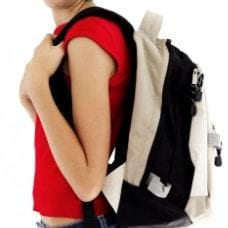From kindergarten onward, backpacks are always a key item on school supply lists. They are a convenient way to make sure your child is adequately prepared for the day’s classes. However, recent studies reveal that stuffing a backpack full has a heavy impact on students’ backs. If worn incorrectly, they could even become the source of long-term health problems.
According to the U.S. Consumer Product Safety Commission, over 7,000 emergency room visits each year are due to backpack-related injuries. In 2010 alone, physicians’ offices, clinics and hospital emergency rooms treated nearly 28,000 strains, sprains, dislocations, and fractures from backpacks.
Young girls are most at risk since they tend to be smaller in frame while still carrying the same weight as bigger classmates. “A child wearing a backpack incorrectly or that is too heavy can be contributing risk factors for discomfort, fatigue, muscle soreness, and musculoskeletal pain especially in the lower back,” says Karen Jacobs, EdD, OTR/L, CPE, clinical professor of occupational therapy at Boston University, and an expert on school ergonomics and healthy growth and development of school-age children.
Injuries occur when backpacks are placed incorrectly on the child’s shoulders. The force can pull the child back and cause the spine to compress unnaturally. Wearing backpacks on one shoulder can be just as damaging, and injuries due to balancing issues are also not unheard of.
Signs of injury include pain, tingling or numbness, red marks on the shoulders and neck and struggling when putting on or taking off the backpack.
To protect children from discomfort and prevent any life long damage, the American Occupational Therapy Association (AOTA) offers simple tips for parents:
· Always select a backpack that is the correct size for your child.
· Make sure the height of the backpack extends from approximately two inches below the shoulder blades to waist level, or slightly above the waist.
· Always wear well-padded shoulder straps on both shoulders so the weight is evenly balanced.
· Distribute weight evenly. Load heaviest items closest to the child’s back and balance materials so the child can easily stand up straight.
· Wear the hip belt if the backpack has one, to improve balance and take some strain off sensitive neck and shoulder muscles.
· Check that the child’s backpack weighs no more than 10 percent of his body weight. If it weighs more, determine what supplies can stay at home or at school each day to lessen the load.
· If the backpack is still too heavy for the child, consider a book bag on wheels if the school allows them.
,





